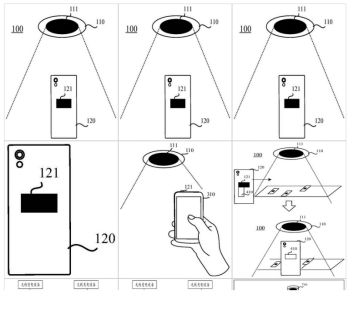Wireless charging was originally discovered around late 19th century, when pioneer scientist Nikola Tesla demonstrated magnetic resonant coupling. The magnetic resonant coupling may be understood as a phenomenon that transmits electricity through air, by creating a magnetic field between two circuits, a transmitter and a receiver. However, for about 100 years wireless charging remained a technology without any actual practical applications. Today, one can find almost half a dozen wireless charging technologies in our day to day use. Wireless technologies were developed with an aim of eliminating use of cables in various devices such as smartphones, laptops, and some kitchen appliances. These wireless devices still require a physical contact between the transmitter and the receiver for powering purposes. Recently, the renowned mobile company Xiaomi released a video showing a mobile phone being charged without any connecting wires or physical contact with a charging station. Xiaomi has termed this concept as 'Air Charging'. This concept has become the talk of the tech world after the video was released.
One might question, exactly how does air-charging work? Well, the Xiaomi Air Charging technology's pile has five phase interface antennas that accurately determine the position of the mobile phone. The phase control array of the pile, comprising 144 antennas, directionally transmits millimeter-wide waves (mm waves) through beamforming. The receiving device, for e.g. a smartphone, needs to have a miniaturized antenna array with a built-in "beacon antenna" and a "receiving antenna array" in order to charge the battery wirelessly. The former helps the pile to identify the smartphone's position, while the latter is a 14 antenna array that converts the millimeter-wave signal into electrical energy through the rectifier circuit. An antenna is a conductor that can transmit or receive electromagnetic signals, an antenna array is a set of multiple connected antennas which work together as a single antenna.
Millimeter waves used in the present technology are electromagnetic (radio) waves typically defined to lie within the frequency range of 30–300 GHz. Until now, only operators of satellites and radar systems used millimeter waves for real-world applications. Now, some cellular providers have begun to use them for data transfer. But using millimeter waves to charge a mobile device is an entirely new approach. There is one major drawback to millimeter waves though, they can't easily travel through obstacles. The prototype limits the charging power to five watts but Xiaomi claims that multiple devices can be simultaneously charged, and its efficiency remains unaffected even in the presence of obstacles. Five Watts can seem rather slow for someone used to the usual 30, 60 or even 120 watts chargers but since the device is continuously charging while being in the range of the charger at the time of its usage, there will be no battery drain which means you won't have to wait for your device to get charged before leaving the house, it will be charged all the time. But this is just the prototype, we might soon get to see a 30-watt variant or even higher just like how wireless chargers have stepped up from 5 watts to 30 watts.
For people on the go, wireless charging is slowly gaining popularity and smartphone manufacturers are increasingly working towards making wireless charging technology seamless. Owing to its increased popularity in the portable device market Air Charging may soon become a trend. Having said that, every performance upgrade in any device, requires better management of battery as well. For example, using 5G on a smartphone drains 25% more battery than 4G. This problem can be solved in two ways, using a bigger battery, or making software modifications to optimize battery usage which will most likely reduce the phone's performance in other domains like gaming. Chipsets are always designed to balance the power consumption and performance because every device has a limited battery. But charging batteries over air could revolutionize how we power our phones and keep us on the grid 24/7. With this technology manufacturers will be able to provide the best possible performance to battery powered devices without worrying about battery management.
With time, we expect that this technology will get refined and it will bring innumerable changes to how electronics are used. With the ability of charging devices in a range of 5 meters, small battery powered devices won't require batteries anymore as they'll be getting continuous supply from the charger block. When this technology gets common, smartphones may be manufactured with a smaller battery or even no battery, changing the complete design since battery is the bulkiest part of a phone. With no battery, there won't be overheating of devices and no more risk of your phone exploding. This will in turn tremendously reduce the amount of e-waste produced.
In a time where we are surrounded with technology, concerns regarding emission of constant radiation in a room may be raised however as this particular model uses the same technology as 5G which is transmission via mm-waves which are non-ionizing, it will not be a health concern and tech giants like Xiaomi might make this technology available to everyone very soon.
Many other companies like MotherBox, WI-CHARGE, Energous have tried to implement this technology in the past but failed. Xiaomi working on this is a big deal because it has the money and the scale to be able to implement it successfully.
If you wanted any indication that this is about to become a huge trend, literally hours after Xiaomi released the video of their prototype, Motorola also released a video saying they are also working on this technology and there must be many others too. Considering how transforming this new technology is, safeguarding the rights to the invention is also very important. To protect this invention from being copied, Xiaomi has filed 17 technology patents around all the components that make air charging possible which Xiaomi can soon start monetizing from.

Figure 1: Snap of a diagram from one of the patents. [Source (Patseer)]
You might think, why 17 patents for one invention? Even though air charging as a whole might look like just one invention, every component that is used in the process is considered as an invention. Separate patent for every component ensures better security and has higher chances of getting granted. Some of the patents filed by Xiaomi under this technology are for:- the method of locating the receiver, the method of transmitting the signal, the transmitting antenna array, the receiving antenna array, the method for converting the mm-wave signal to electric charge, the long distance charging equipment, and on the communication method between the transmitting and receiving equipment.
The importance of filing patents in the ever-evolving field of technology therefore cannot be overemphasized upon. Whether you are an investor, general counsel, researcher, inventor or CEO with an interest in technology – protecting and optimizing your IP portfolio is essential.
The content of this article is intended to provide a general guide to the subject matter. Specialist advice should be sought about your specific circumstances.



